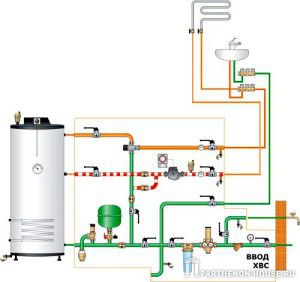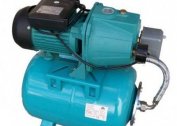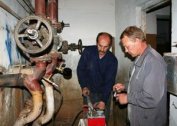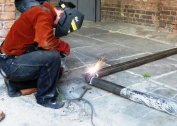A water supply system is a set of designs that supply certain consumers with water of the required quality and quantity. In everyday life, a water supply system is called a water supply system. The water supply system must work stably, maintaining the quality and pressure of water in a given framework.
Types of water supply systems
The types of water supply systems differ in several main parameters. By appointment water pipes are:
- settlements (villages, cities);
- production purpose;
- agricultural purpose;
- combined (agricultural fire);
- fire fighting.
According to the method of water delivery types of water supply systems to the consumer are:
- with mechanical delivery of water (pumps);
- self-flowing;
- zone (combined mechanical and gravity method).
By type of water supply:
- water pipes connected to surface sources (lakes, rivers);
- connected to underground sources (artesian, sand wells, springs);
- combined.
According to the method of using water All water supply systems are divided into the following types:
- direct-flow (water is used only once);
- with repeated use of water;
- negotiable.
Central or autonomous water supply
In addition, by the number of consumers, the water supply can be autonomous (individual) or centralized.
Autonomous water supply systems supply water to a limited number of consumers and are owned by private users. The individual look of the hot and cold water supply system is widespread in private buildings, in cottages, in cottage villages. The source of water intake is located near the house, a pump is lowered into it. Water is supplied to the house through a pipeline equipped with a filter.
Centralized water supply It is designed to supply water to a large number of consumers. All of them use water from a single system, supplied through a piping system. Usually this type of system combines hot and cold water. One or several sources can be used for water intake; water, water-lifting, treatment facilities are used in water treatment.
This type of hot water system is used in cities and large towns. Depending on the served territory, centralized water supply systems can be urban, industrial, or urban.
Types of water sources
The water supply system begins with a source of water intake. Depending on the type of water supply source, it is determined: the number and composition of structures, the duration of pipelines, the capacity of pumping stations.
All types of water supply sources must meet a number of criteria:
- the amount of water should be sufficient taking into account a possible increase in consumption;
- the possibility of uninterrupted water supply;
- after inexpensive cleaning, the water quality meets sanitary standards;
- water supply is provided at minimal cost;
- water withdrawal does not destroy the region’s ecosystem.
Sources of water supply are:
- superficial (rivers, seas, ponds and lakes, glaciers);
- underground (aquifers, underground water bodies);
- artificial (desalination plants).
Surface water often muddy, its quality is unstable, it has a lot of microbes and organic impurities. However, it has few mineral salts.
Groundwater stable quality, there are practically no suspensions, organic substances in it, but there can be many mineral salts, increased rigidity.
Artificial water sources are rarely used in the United Arab Emirates, Israel, and Kazakhstan.
Types of pumping stations
The task of the pumping station is to supply a sufficient amount of water to the pipeline. Without a pump, it is impossible to organize mechanical delivery of water to the consumer.
Types of water pumping stations are divided into:
- production;
- household.
The industrial or industrial type of water pumping stations works with large volumes of water. Under high load, they are equipped with backup units, powerful vacuum and circulation pumps. They are reliable, and their repair is carried out by replacing the elements.
Household types of water pumping stations:
- Automatic
- self-priming.
In household pumping rooms, the water pressure is controlled by a special type of membrane tank - a hydraulic accumulator for water supply. The following types of accumulators for water supply are distinguished:
- vertical
- horizontal.
In automatic pump rooms, this function is performed by an electronic control system.
In addition, there is a separate category of sewage pumping stations. This is a large equipment consisting of several pumps, a pipeline and many sensors.
Types of pipes for water supply systems
Cast iron pipes still used for plumbing and sewer networks. They are very strong and durable. It is heavy and difficult to mount.
Steel pipes for water supply can be galvanized or without coating. The advantages of this type of pipe for water supply:
- durability;
- rigidity;
- reliability;
- strength.
Steel pipes are difficult to install, and eventually rust, their throughput decreases. To install a water supply system from this type of pipe, a special plumbing tool is required, and the joints must be additionally sealed.
Copper pipes widely used in water supply systems abroad. Water copper pipes are: in a polyethylene shell, annealed, solid and semi-solid. Their installation does not require special equipment, they are durable and durable, but the high price limits the range of their use.
Plastic pipes are a combination of two layers of plastic and one layer of soft metal. They are flexible, durable, fastened together with clutches and nuts. You can cut a metal-plastic pipe with a simple hacksaw. But this type of pipes for water supply weakly keeps water hammer, periodically all connections must be checked for leaks.
Polypropylene pipes are becoming increasingly common in individual and centralized water supply systems. For hot water supply stations, this type of pipe is produced foil.
Propylene pipes are very durable, do not rust, are easy to assemble, therefore, when repairing city communications, steel water mains are gradually replaced with plastic ones. Between themselves, polypropylene pipes are soldered with a special soldering iron, creating a tight connection.
Video about installing polypropylene pipes:






